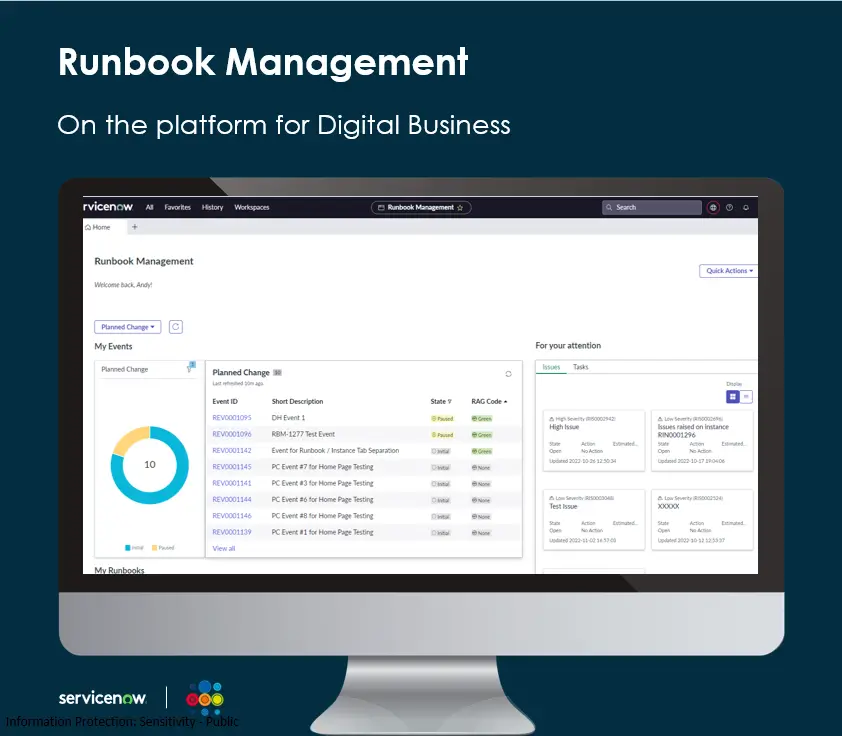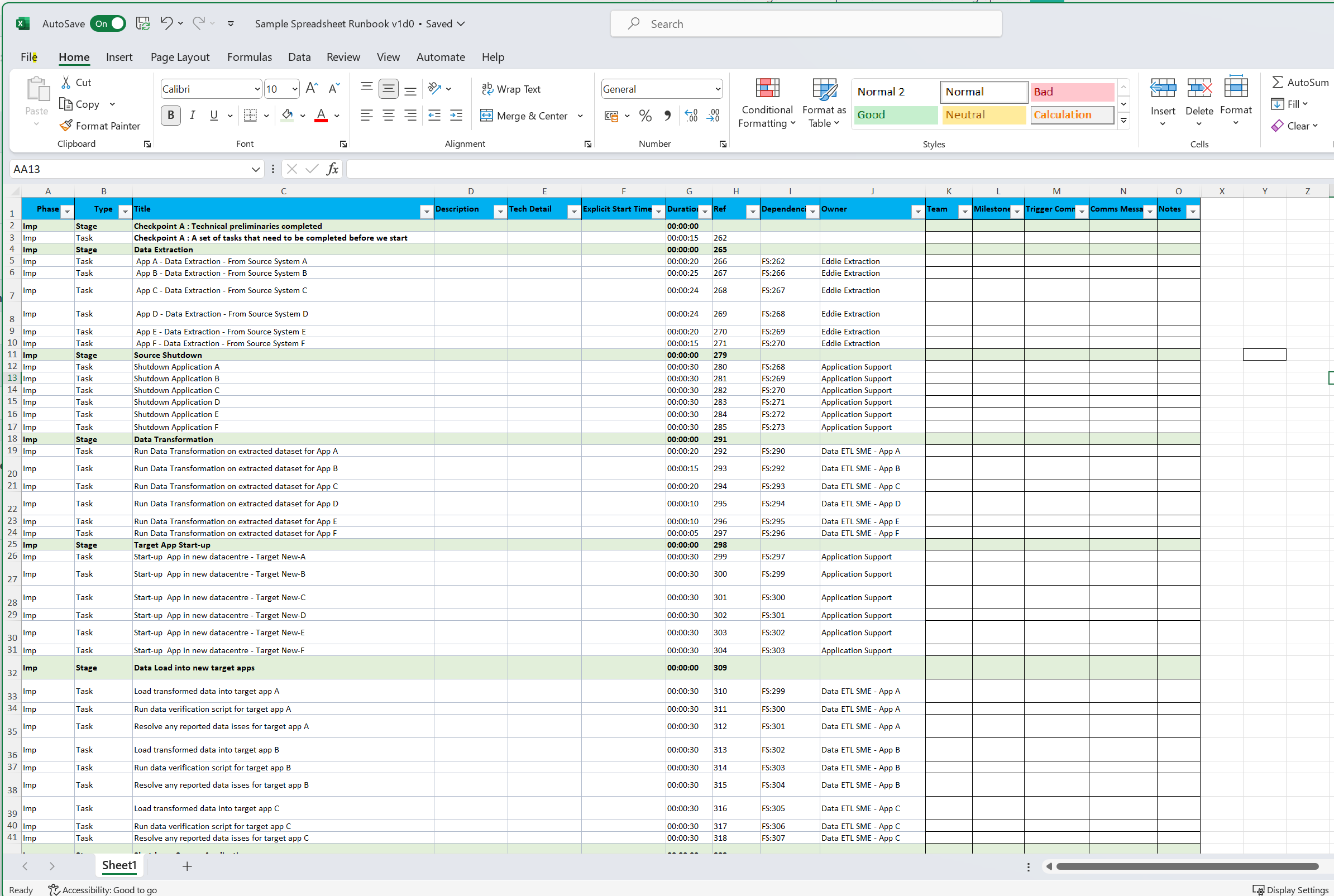2 min read
At last! Digital Runbooks on the ServiceNow platform.
The Strategic Opportunity of Runbook Management on ServiceNow® In an era where Operational Resilience is not just an advantage but a necessity,...
7 min read
 Marketing Team
:
Mar 14, 2024 10:16:05 AM
Marketing Team
:
Mar 14, 2024 10:16:05 AM

Organisations across every sector are critically dependent on technology systems to run their business, to operate their supply chain and to serve their Customers. All businesses face the common challenges of delivering rapid technology change, recovering quickly from any technology failures, and planning for business continuity if some form of disaster scenario occurs.
To achieve all of that, businesses need to invest in Operational Resilience – a fact that more and more boards across the globe are recognising and responding to with significant investment plans.
In highly regulated industries, there is the additional incentive to meet new Operational Resilience regulations. A great example is the DORA Regulations in the Financial Sector in European countries. Regulation is just a lever, albeit a powerful one and should be viewed as a further incentive for businesses to invest in this key capability.
The real strategic driver for building rock-solid technology resilience capabilities is to meet the needs of Customers, Partners, Employees, Shareholders, Markets and even Society itself. Operational Resilience is not a destination but process of continuous improvement and innovation.
To successfully achieve operational resilience, organizations need to lay the right foundations. Fortunately, many CIOs have had the foresight to select ServiceNow® as their organization's strategic platform for IT Service Management and much, much more.
This has traditionally been the first solution that triggers the adoption of ServiceNow® by a Customer. The solution implements the core ITIL-based processes that are required to provide comprehensive IT Service Management to a business.
This includes the following fundamental ITIL processes:
ITSM encompasses a set of policies, processes, and procedures that align IT services with the needs of the business. It helps organizations streamline their operations, improve service delivery, and enhance customer satisfaction. By implementing ITSM best practices, organizations can establish a solid foundation for Operational Resilience.
Effective IT Service Management (ITSM) strategies depend upon a robust configuration management database (CMDB). The development of a cohesive suite of interconnected solutions hinges on a unified data model that seamlessly integrates all components.
ServiceNow® excels in meeting these critical requirements.
The ServiceNow® configuration management database (ServiceNow® CMDB) is a centralized repository that stores information about the configuration items (CIs) within an organization's IT infrastructure. It provides a comprehensive view of the relationships and dependencies between various CIs, enabling organizations to understand the impact of changes and make informed decisions.
The Common Services Data Model (CSDM) is a framework that defines the structure and relationships of configuration items (CIs) and services within an organization. It provides a standardized approach to organizing and managing data, facilitating better collaboration and integration between different teams and departments.
ServiceNow® has it's own definition as published within the CSDM Executive Brief:
Common Service = A standard and shared set of service-related definitions across ServiceNow® products and platform that will enable support.
Data Model = A Configuration Management Database (CMDB) framework across ServiceNow® products and platform that will enable and support multiple configuration strategies.
By embracing ServiceNow® to lay the foundations of ITSM, CMDB, and CSDM, organizations have established a solid base for operational resilience and ensure they have the necessary visibility and control over their IT assets, processes and operations.
A massive part of Operational Resilience is defining what's important to your business, what adverse events could impact your business and to then identify and manage the operational risks that you are carrying. Some of these risks will be within an organisation's risk appetite, other will not. Capabilities will be defined, implemented and verified.
Achieving operational resilience requires organizations to go through a risk, audit, and compliance phase. This involves identifying potential risks, conducting audits to assess the effectiveness of existing controls, and ensuring compliance with relevant regulations and standards.
ServiceNow® offers a suit of solutions under the Governance, Risk & Compliance (GRC) portfolio. These solutions include the following:
During the risk assessment phase, organizations need to identify and evaluate the potential risks that could impact their operations. This includes assessing the likelihood and impact of various risks, such as cyber attacks, system failures, and natural disasters. By understanding the risks they face, organizations can develop appropriate mitigation strategies and contingency plans.
Audits play a crucial role in assessing the effectiveness of existing controls and processes. They help organizations identify areas of improvement and ensure that they are operating in accordance with industry best practices and regulatory requirements. Regular audits provide valuable insights and enable organizations to proactively address any compliance gaps or vulnerabilities.
Compliance with relevant regulations and standards is also essential for operational resilience. Organizations need to stay up to date with the latest regulatory requirements and ensure that they have appropriate controls and processes in place to meet those requirements. This includes data protection regulations, industry-specific standards, and internal policies.
By going through a comprehensive risk, audit, and compliance phase, organizations can identify and address potential vulnerabilities, strengthen their controls, and enhance their operational resilience.
With a solid foundation in place and the integration of strong Risk, Audit, and Compliance solutions, organizations can enhance their operational resilience by implementing advanced solutions customized for specific business scenarios.
These additional solutions provide custom features designed for their use case scenario and complement and interact with the existing foundational services and core risk management framework. Ultimately this strengthens the overall operational resilience capability, demonstrating the Better Together proposition that is at the heart of ServiceNow®'s product strategy.
Examples from the ServiceNow® solution portfolio include the following:
With ServiceNow® widely recognised as the strategic platform for achieving Operational Resilience, companies are accelerating their product journey from core ITSM to advanced risk solutions to a growing portfolio of other ServiceNow® solutions. Collectively, they are building strong capabilities with huge benefits as they build this ecosystem of complementary, mutually enriching solutions.
Yes, that's great progress, but .... there’s a but, and it’s a big but.
Despite all this investment, all this innovation and all the capabilities that the ServiceNow® platform and these solutions bring, we are still seeing the continued use of spreadsheet runbooks:
The continued use of spreadsheet runbooks and the accompanying operational methods result in excessive operational risk, heightened uncertainty, inefficiencies, and significant costs for all involved.
The spreadsheet runbook represents the horse and cart in the age of electric vehicles.
Let’s highlight a few real-world examples where the continued use of spreadsheet runbooks ramps up operational risk and undermines an organization's operational resilience capability:

|
The Project Manager, using Strategic Portfolio Management (SPM) to build and manage programme and project plans ... |
|
... but still reaching for Excel to build the go-live cutover plans. |

|
The Incident Manager, using the most modern and powerful IT Service Management (ITSM) solution on the global market ... |
|
... but still reaching for Excel to build the incident recovery plans. |

|
The Operational Resilience specialist, using Business Continuity Management (BCM) to define and run Business Continuity and ITDR Events ... |
|
... but still reaching for Excel to build the technology recovery plans. |
Right now, in organisations across the globe, there’s huge investment underway in tackling the Operational Resilience challenge.
If you've already invested in ServiceNow® you're in a good place.
Whether you're just laying down the foundations or already have your risk, audit, and compliance solutions in place, or even utilizing specific business solutions, the key is to prioritize digital runbooks on the platform. It's a strategic move that ensures operational resilience and efficiency, no matter where you are on your organizational journey.
Before investing further in spreadsheet runbooks, digital runbooks on the ServiceNow® platform are the way forward.
To truly address the Operational Resilience challenge, we must bid farewell to spreadsheet runbooks, once and for all.
That’s where Runbook Management, a native ServiceNow® application, fits as the missing piece of this complex jigsaw. By leveraging the power of the ServiceNow® platform and implementing digital runbooks, organizations can take a significant step towards achieving operational resilience in the digital age.
Implementing Runbook Management, and embracing digital runbooks, offers several benefits for organizations striving to achieve operational resilience.
Working in harmony with your other solutions, Runbook Management gives you:
As we have seen already, ServiceNow® has emerged as a strategic platform, moving way beyond it's original market leader position as in IT Service Management solution. As the solution portfolio grows on the platform, the sharply defined boundaries between different solutions are being blurred as a unified data model and common business processes becomes the norm.
This isn’t really integration as we know it today. This is the fluid, blending of solutions together, where the user seamlessly transitions from one product to another from a single, shared user interface. The ServiceNow® platform with the Common Data Service Model is the foundation that enables this Better Together vision to happen.
In addition to this Better Together vision, the ServiceNow® platform offers huge scope and potential for efficiency, optimisation and collaboration.
Runbooks will be optimised by integrating DevOps tools to automate the manual tasks that are performed today. Content Packs will capture detailed instructions that can be updated, optimised, automated, and propagated to existing runbooks. Collaboration will be enhanced – with notifications and warnings flowing to the right people, at the right time, in the right collaboration tool whether that’s Sidebar, MS Teams, Slack.
Then we have Gen AI, where the platform itself will deliver capabilities that we are only just beginning to envisage.
In summary, the future for Operational Resilience entails a continuous journey of enhancement and creativity. For organizations dedicated to the ServiceNow® platform, embracing Runbook Management as a fundamental element of their Operational Resilience strategy is crucial. Integrated into the solution portfolio, Runbook Management empowers organizations to drive efficiency, accelerate processes, enhance clarity, and maintain consistency, ultimately reducing operational risks and cutting down on operational costs significantly.

2 min read
The Strategic Opportunity of Runbook Management on ServiceNow® In an era where Operational Resilience is not just an advantage but a necessity,...

Explore the evolution of runbooks from legacy manual documents to modern digital solutions, and discover which option best suits your needs.

Operational Resilience in the Financial Sector Operational resilience is the ability of financial institutions to continue to operate effectively and...